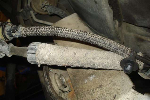I just finished reading your other thread from beginning to end. My first comment is that I commend you for your persistence in trying to resolve the rough idle issue. Today is the anniversary of the documentation of the problem. In my years on this forum I encountered another member (Dick Berg) who also had an unsolvable rough idle on his 2nd generation Explorer. He, like you, tried everything that I and others suggested but was never able to win the battle. I never got over not being able to help him enough and I don't want to experience that again. I wish that I was as knowledgeable on the 3rd generation PCM logic as I have become on the 2nd generation but now that I have a 2003 Centennial Explorer (with 4.6L) I hope to catch up.
The idle speed control implementation is a closed loop system. As I recall there are calibration constants for desired idle speeds in Park/Neutral, for A/C compressor engaged/disengaged, and when transmission is engaged and the vehicle is moving slower than a specified speed. The PCM commands the IAC valve to a duty cycle and determines the engine speed using the crankshaft position (CKP) sensor signal. The PCM compares the actual engine speed to the desired engine speed and adjusts the duty cycle to reduce the error. I seem to remember that the PCM stores the corrections in a table to reduce the repetition of learning them each drive cycle. The accuracy of the CKP sensor and the accuracy and response lag of the IAC valve affects the deviation of the idle speed. If the IAC valve is slow to respond to a commanded duty cycle change then the PCM will command a larger change. If the IAC valve is inaccurate it may overshoot the commanded duty cycle causing the PCM to command a new duty cycle in the opposite direction to compensate. The result is a varying (oscillating) idle speed. A fast response IAC valve will increase the frequency of the oscillation. An accurate IAC valve will reduce the amplitude deviation of the oscillation. According to your other thread's description of the rough idle this oscillation may not match your symptoms. What are your min and max engine speeds at idle in park when the engine is fully warmed up? Are you able to read the commanded idle speed PID?





















